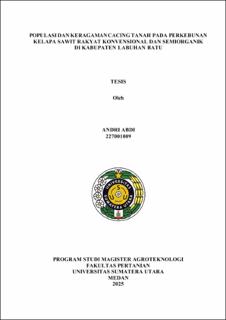Populasi dan Keragaman Cacing Tanah pada Perkebunan Kelapa Sawit Rakyat Konvensional dan Semiorganik di Kabupaten Labuhan Batu
Earthworm Population and Diversity in Smallholder Oil Palm Plantations under Conventional and Semi-Organic Systems in Labuhan Batu Regency

Date
2025Author
Abdi, Andri
Advisor(s)
Sabrina, Tengku
Sembiring, Mariani
Metadata
Show full item recordAbstract
Oil palm (Elaeis guineensis Jacq.) is a key plantation crop for Indonesia's economy. Most smallholder farmers use conventional farming systems, which have adverse effects on both microfauna and macrofauna, particularly earthworms. This study aimed to examine the relationship between earthworm population and diversity in conventional and semi-organic farming systems in oil palm plantations. The research was conducted across 18 smallholder oil palm plantations over 10 years old in Labuhan Batu Regency, North Sumatra, from October 2023 to April 2024. Samples were collected from 18 productive plantation sites, with three samples taken per site, resulting in a total of 54 samples (n=54). The study employed a survey method, and samples were selected using purposive sampling techniques. The results showed that soil parameters positively correlated with earthworm populations included pH, sand content, and soil organic carbon (C-organic), while soil moisture content had a negative correlation. For earthworm diversity, positive correlations were observed with soil pH and sand content, whereas negative correlations were found with soil moisture and organic carbon content.
Collections
- Master Theses [428]
